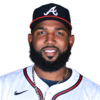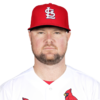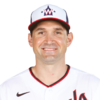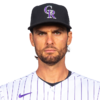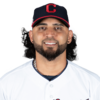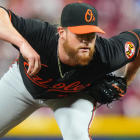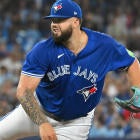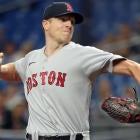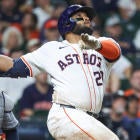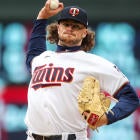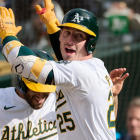- Draft Prep Tiers: C | 1B | 2B | SS | 3B | OF | SP | RP
- Heath's Sleepers 1.0 | Breakouts 1.0 | Busts 1.0
- Scott's Top 100 prospects | Sleepers 1.0 | Breakouts 1.0 | Busts 1.0
I'm about to blow your mind with meanness.
Cruel intentions, I have, to prey on the meek and crush the unsuspecting. No one can stop this tempest of sage counsel. It's advice Armageddon, your team crumbling under the weight of its own improvement.
I want you to win, loser, and I don't care who I have to take down to make it happen. I'm on a recommendation rampage, terrorizing you with tips and sound judgment. And I won't even charge anything because deep down, I like it. Twisted though it may be, your success is my serum, and I'll strangle you with statistics just to make you see ... to make you see ...
First place. In your face. Drop that vase. It's happening. Out of left field. Into the hot seat. Get ready. Let's bust it.
The damage I inflict here has purpose, so take heed. Though painful to hear now, it's the help that you need.
I don't know why we have to fall for it again.
From time to time throughout his now 11-year major-league career, Justin Upton has had seasons in which his production reaches another level. He's not a fundamentally different player, but he's a little better all around. And 2017 was one of those seasons.
It just seems like every time it happens, it becomes his expected baseline production. He gets drafted like the best version of himself rather than what he usually is.
What he usually is is a solid starter in any format, but not a third-round pick, like his FantasyPros consensus ranking suggests. Not anywhere close.
His .341 BABIP was his highest in seven years, yet he hit only .273 ... which itself was his highest in five years. He strikes out so much -- a rate that appears to be rising, it's worth pointing out, in accordance with the league-wide trend -- that's he's normally condemned to a batting average in the .250 range.
Meanwhile, his .268 ISO was his highest ever. Shoot, only once in the previous five years had he even topped .220. A power breakthrough at age 30 is suspicious, particularly for a player who has been in the league since age 19. I don't mean that in accusatory way. I just mean we probably shouldn't take it so seriously.
It's a mathematical quandary -- and one I don't think you can explain just by him being in the same lineup as Mike Trout. After all, he was doing the same things in Detroit during the first two-thirds of last season with little to no help from a broken-down Miguel Cabrera.
Upton may not be a bust in the traditional sense -- where the bottom falls out, leaving his Fantasy owners trembling amid the rubble -- but he'll underwhelm you at his going rate.
"Bust" probably isn't the most appropriate term to describe Marcell Ozuna either. The disaster potential rates fairly low. He'll hit his share of home runs and drive in plenty as the new big bat in the heart of the Cardinals lineup. But the specifics matter.
Will he hit 37 home runs as he did last year, exceeding his previous high by 14? Most likely not. Will he drive in 124 as he did last year, exceeding his previous high by 39? Well, not without as many home runs. Will he hit .312 again after previously settling in as a .265 hitter? The percentages all say no.
Chief among them is a .355 BABIP. Some players legitimately do profile as .350-BABIP guys -- a rare, uniquely gifted few whose contact mainly manifests as line drives. Ozuna's 19.3 percent line-drive rate last year was in the bottom third of the league and not at all a departure from career norms.
What was a departure? His home run-to-fly ball rate -- a bloated 23.4 percent thanks in part to a modest 33.5 percent fly ball rate. He was the only player with a percentage that low to hit even 30 home runs.
Again, not a disaster here, but the bottom line is Ozuna's BABIP and home run-to-fly ball rates in 2017 were just a little too high to believe, and yet at 40th overall, you're paying for the production they yielded. Let one of your competitors do that.
First of all, we need to forget 2016 happened. Wipe it from your memory. Regard it as but a figment of your imagination.
And it's pretty easy to do if you just look at his year-by-year numbers since joining the Mariners in 2014. One of these things is not like the others:

So ... fluke. We're on the same page, then. Great.
But then we should also be on the same page with this: He doesn't need to go 53rd overall, as he's currently ranked on FantasyPros, ahead of Tommy Pham, Justin Turner and Khris Davis, to name a few. They averaged 3.63, 3.45 and 3.20 Fantasy points per game, respectively, last year. Cano averaged 3.04.
Oh, but he's a second baseman. You have to pay more for a good one of those.
OK, but how good is he really? The problem with second base is a lack of true standouts. There's Jose Altuve. There's Jose Ramirez. There's Brian Dozier. There's Daniel Murphy. And if you want to count Dee Gordon for what he contributes in categories leagues, fine. But that's it. Maybe Whit Merrifield if you trust him to fully repeat his 2017. But that's it.
For everyone else -- a span of about 15 players -- we're talking marginal differences, attributable mostly to variable levels of assurance. That's more or less what separates Cano, my sixth second baseman, and Jason Kipnis, my 18th.
And then when you consider Cano is 35 and has declining walk and line-drive rates, I'm thinking it might be better to grab an Ozzie Albies or Yoan Moncada (both on my Breakouts list) 10 rounds later. They're more likely separate themselves from the pack than Cano is at this stage of their careers.
Again? You're making me do this again, after getting it right last year? After doing my part to educate the world about the pitfalls of Xander Bogaerts only to have to witness it play out like Dr. Malcolm in Jurassic Park.

Once more with feeling, y'all.
Bogaerts doesn't do anything especially well, and he doesn't do many things even moderately well. He has twice done a good job of faking it -- in 2015, when his .320 batting average carried him, and in 2016, when his 21 home runs carried him.
Faking it, I say? Allow me to demonstrate.
Here are his year by year BABIPs (via FanGraphs):
2014 | .296 |
2015 | .372 |
2016 | .335 |
2017 | .327 |
Here are his year by year home run-to-fly ball percentages (also via FanGraphs):
2014 | 7.1 |
2015 | 5.3 |
2016 | 11.4 |
2017 | 7.2 |
I'll connect the dots for you. Both of the years in which he had the appearance of a Fantasy standout were built on anomalies -- an uncharacteristically high BABIP one year and an uncharacteristically high home run-to-fly ball rate the next. And nothing in his batted-ball profile would suggest a change is on the horizon.
Now, you will find people -- honest, hard-working people -- who make this claim:
No way! People forget that Bogaerts had the wrist injury last year. Look what he did when healthy. Can't get behind this.
— Rich (@rbenny43) January 23, 2018
But you know what? I'm not buying it. What he did when healthy was hit all of two home runs in the first 2 1/2. The success he had prior to the plunking was driven by two numbers: a .308 batting average, which was built on the same sort of BABIP (.367) that made fools of us all in 2015, and nine stolen bases, which were obviously out of character and in no way slowed by a wrist injury. I don't blame health. I blame natural regression, and I'm happy to double down on that view this year, with Bogaerts still sitting at 61st overall in FantasyPros consensus rankings.
At age 25, he still has time to live up to all of his potential, but I need to see actual changes to his batted-ball profile before I'm willing to forecast it.
Ryan Braun is Fantasy royalty, and Fantasy royalty tends to get the benefit of the doubt. But over the past several years, a few troubling trends have emerged, and last year showed what happens when they converge.
It was a bad season by his standards. It was a bad season by 2017 standards. His 3.06 Head-to-Head points per game were eclipsed by the likes of Eduardo Nunez, Marwin Gonzalez and Michael Brantley.
And of course, per-game production isn't the fairest way to assess Braun anymore, not when missing games is the norm. Even if you're willing to excuse the six weeks he missed with a strained calf last year -- which is awfully generous of you seeing as he's no stranger to DL time at age 34 -- it doesn't change the way the Brewers handle him in between DL stints, resting him every five days or so to keep his thumb, wrist and back in working order.
It's sort of the way the Giants handled Barry Bonds in the latter stages of his career, which worked out OK for his Fantasy owners because, you know ... Barry Bonds. But Bonds Braun is not, and he's finding it more and more difficult to meet the threshold required for a less-than-everyday player to deliver in standard mixed leagues.
The problem is one several years in the making: He doesn't elevate the ball like when he was one of the most feared sluggers in the game.
| Fly-ball rate by year, according to FanGraphs | ||||||||
2007 | 44.9 | |||||||
2008 | 44.1 | |||||||
2009 | 33.9 | |||||||
2010 | 34.9 | |||||||
2011 | 37.4 | |||||||
2012 | 38.1 | |||||||
2013 | 32.4 | |||||||
2014 | 33.0 | |||||||
2015 | 31.0 | |||||||
2016 | 25.1 | |||||||
2017 | 31.9 | |||||||
Last year's rate of 31.9 percent would have ranked 112th among all qualifiers, down there with Chase Headley, Andrelton Simmons and, yes, Xander Bogaerts -- you know, some of the few players who aren't hitting 20-plus homers at a time when everybody who's anybody does.
Braun got away with it in 2016, when he homered 30 times in 511 at-bats, because of an uncharacteristically high home run-to-fly ball rate (28.8 percent), but if he wasn't homering at that clip in his younger, studlier days, why should we believe he will now?
Royalty or not, he's probably like a fourth outfielder in Fantasy Baseball these days.
Two years in a row Jake Lamb convinced us he was breaking out only to disappear in the second half. I'm not letting it happen a third time.
The first-half/second-half split isn't especially revealing to me, but the fact he couldn't sustain an All-Star level of production over a full season is.
And he has a glaring enough flaw for me to wonder if it'll always be the case.
The guy stinks against left-handed pitchers. Big deal, right? Most left-handed hitters do. But there's a difference between keeping one's head above water and doing whatever Lamb did last year, hitting .144 with a .557 OPS against them. It wasn't an isolated event either. In 2016, he hit .164 with a .625 OPS against lefties.
By the final two months of 2017, the newly contending Diamondbacks had seen enough, sitting him against the majority of left-handed pitchers in favor of Adam Rosales. Now with Yasmany Tomas returning and Brandon Drury without a position, it'll be even easier to justify.
And that's the clincher for me. Not only do Lamb's struggles against left-handed pitchers require him to perform at an MVP level against right-handers -- which is difficult to sustain from month to month, much less year to year -- but they also may have rendered him a platoon player, making him a souped-up third base version of Lonnie Chisenhall.
Mixed-league owners can do better -- certainly in Round 8, where FantasyPros consensus rankings project him to go in a 12-team league.
Already in this space, I've noted a couple players who don't have true bust potential but are likely to just, you know, underachieve.
Jon Lester, meanwhile, is standing over the trap door, stammering through an explanation of why there are no sharks with laser beams on their heads.
He's toast.
He may be, anyway. Granted, I thought he was in 2013 as well, and then he went on the best three-year stretch of his career, which gives me some pause. But the evidence at this stage of his career is a little more damning.
From 2016, his average fastball velocity dropped by more than 1 mph. And while we see some fluctuation for most every pitcher from year to year, establishing a new low is of particular concern for a 34-year-old, especially one whose strikeout rate -- not K per nine, but true strikeout percentage -- fell to its lowest mark since 2013, when the league as a whole was less strikeout-prone. He didn't have a way to make up for the reduced rate either, with his walk and home runs only rising in response.
In other words, he looked like a pitcher with diminished stuff at an age when it only stands to reason. He's at a point where he might need a reinvention of sorts to function as more than just an innings eater. CC Sabathia has finally gotten to that point over the past two years, but it was a multi-year ride to get there. I'm concerned Lester will go the way of Adam Wainwright, Felix Hernandez and -- if I'm not speaking too soon on this one -- Cole Hamels. Those who ignored the warning signs for those three had a front-row seat to the disaster.
Innings eaters are still valuable in this landscape, when removing a pitcher before he goes six is all too common, so there's certainly a point when I'd draft Lester myself. I feel like he's getting too much benefit of the doubt, though, amid some troubling signs.
Some people like Jose Berrios. I don't.
I could if I wanted to. He had a 2.15 ERA, 0.94 WHIP and 9.8 strikeouts per nine innings in 23 starts over the last two years at Triple-A Rochester. I like that. He was the No. 36 and No. 28 prospect, according to Baseball America, in his last two years of eligibility. I like that, too.
Here's what I don't like: His actual performance in the majors so far.
Don't get me wrong: His final line was fine, particularly for a rookie and particularly after that dreadful start to his career in 2016. But it was built primarily on an unrealistic eight-start stretch in which I get the sense he caught the league by surprise (and possibly relying on those scouting reports from 2016, when his command was all screwed up). Over his final 18 appearances last year, 17 of them starts, he had a pedestrian 4.61 ERA and 1.43 WHIP.
Again, not a deal-breaker necessarily. I like pedigree. I like stuff. He appears to have both. The problem is perception -- or more accurately, the presumption that either his final-season line or his performance in those first eight starts was his truest, purest self.
But that's not what I see.
I see a pitcher who for the entirety of 2017 -- good stretches and bad stretches included -- produced a swinging strike rate that was below league average, according to Baseball-Reference. His 16.9 percent mark ranked 58th among qualifying pitchers, down there with Chad Kuhl and the gang. All things considered, it's a wonder he struck out as many as he did, and by 2017 standards, his 8.6 strikeouts per nine innings were pretty modest to begin with.
Again, it's one thing to take a flier on him and hope for improvement, but that's not what's happening here. FantasyPros consensus rankings have him 29th among starting pitchers, ahead of mainstays like Johnny Cueto, Marcus Stroman and Sonny Gray.
It was fun while it lasted, right? Once an early-round fixture, Ryan Zimmerman rebounded from a couple injury-plagued years with better-than-ever production early in 2017, cementing his place in all Fantasy lineups for the duration of the season.
But by the end, he probably didn't deserve it.
Don't get me wrong: The final numbers are indeed impressive, but they pretty much had to be after the way he started the season. He was like an in-his-prime Miguel Cabrera, batting .330 with 19 home runs and a .969 OPS through the All-Star break, but there wasn't much explanation for it. Nothing changed in the underlying numbers. He wasn't a part of the fly-ball revolution, improving his bottom line the way Daniel Murphy and Justin Turner have. He didn't adjust his approach the way Justin Smoak did. The prevailing theory was "well, I guess this is what happens when he stays healthy," except it never was in his younger, sprier days.
And it didn't turn out to be last year. How could it? It was a built on a .364 BABIP. Zimmerman's second half, meanwhile, was built on a .299 BABIP, much more in line with his career .311 mark, and he hit .269 with 17 home runs. It averaged out to 3.09 Fantasy points per game -- or about what Smoak averaged over a full season. If that's the more likely level of production for him, I don't know that it's worth even a mid-round pick.
And there's always the chance he gets hurt again.
Remember last spring, when Bird mania was sweeping the nation?
Greg Bird, the Yankees 25-year-old first baseman, had recovered from a torn labrum in his shoulder and was homering seemingly every other day as Fantasy owners tripped over each other to draft him earlier and earlier in a frenzy not seen since the days leading up to Kris Bryant's debut.
Remember that? Crazy, right?
Yeah, FantasyPros consensus rankings have Bird going even higher this year.
I'm trying to jog my memory here, because I don't think he actually delivered on the hype of last spring. There was that one guy ... but wait. No, it was Cody Bellinger, not Bird. No, as a recall, Bird was a disaster for the first four weeks, striking out 22 times in 60 at-bats while homering exactly once before landing on the DL with a ankle bruise that never would get better.
OK, so it eventually did, and he himself was better when it did, but I don't remember him carrying Fantasy teams down the stretch the way Rhys Hoskins and Matt Olson did. No, he hit .253 with eight home runs and an. 891 OPS in 29 games for an average of 3.03 Fantasy points per game -- or about what Brandon Belt averaged before suffering his season-ending concussion.
Is that worth more than J.T. Realmuto? Or Jay Bruce? Or Joey Gallo? Because that's who Bird is ranked ahead of -- not by me, but by the industry as a whole. And based on what? A couple clutch home runs in the playoffs? Check out that postseason line again. He also hit .244 and struck out in more than one-third of his at-bats. I'm not saying that's who he is, but my point is I still don't know who he is. And neither do you. Apart from that magical spring training, he has yet to do anything to suggest he's deserving of this leap of faith.
I buy he has breakout potential, especially if he gets to bat behind Aaron Judge and Giancarlo Stanton. But in taking him where you'd have to take him, you're passing up assured production for a dangerously unproven player.
If you're still drafting Danny Salazar to be an integral part of your pitching staff, you're either a velo-file or a glutton for punishment. Either way, you're getting what you deserve targeting him 144th overall, as he's projected to go according FantasyPros consensus rankings.
Maybe you'll be surprised to learn he's 28 now. Yeah, 28 and still looking for that breakout season. It could happen. Every blue moon, a Tommy Pham type makes good on his potential five years after he was supposed to. But you know, we weren't drafting Pham in Round 12 last year because it would have been as crazy as drafting Salazar there now.
Oh, you could point to a couple brilliant efforts last year -- the six-inning, 11-strikeout gem April 12 and that five-start stretch after coming off the DL in which he compiled a 1.39 ERA, 0.84 WHIP and 12.8 strikeouts per nine innings. But what happened thereafter? A return to the DL and eventual banishment to the bullpen.
He's not durable. He's not efficient. In five years on the job, only once has Salazar masqueraded as such, 2015, and he had a 3.62 FIP.
Enough already. An arm like his is best served in the bullpen, and with Mike Clevinger breaking out last year and Josh Tomlin still in the fold, the Indians have every excuse to move Salazar there for good.
Don't say I didn't warn you.
One thing that isn't in dispute here: Ian Happ has power.
He can hit home runs, he has proven it in both the minors and the majors, and in a different time, under a different set of circumstances, I can see how it might even make him a breakout candidate in Fantasy Baseball, particularly with his second base eligibility.
But not with where the game is right now. Not with where he is right now.
He, of course, is with the Cubs and their oodles and oodles of infielders. They have three starting-caliber second basemen, and if the postseason is any indication, Javier Baez is the top dog of that group. Ben Zobrist is under contract for another $29 million and will steal starts as well.
Happ's at-bats, then, will have to come primarily in the outfield, and while the Cubs have question marks at all three of those spots -- Kyle Schwarber got sent to the minors for a stretch last year and can't hit lefties, Albert Almora has yet to prove he can play every day or succeed against righties, and Jason Heyward is basically just a money pit at this point -- they also have great incentive to stick with what they have.
Happ will play, maybe even enough to collect 450 at-bats or so, but lacking a position of his own puts a clear ceiling on what he can provide for you this coming season -- a ceiling further capped by his skill set.
Yeah, he can hit home runs, but if you haven't noticed, so can just about everyone else in the game today. Unless it's Joey Gallo-level power, a hitter kind of needs to do something else. And I'm not convinced yet Happ will. His strikeout rate last year -- which would have been fourth-worst among qualifiers, ahead of only Gallo, Chris Davis and Trevor Story -- meant his .253 batting might be the peak of what he can provide, and his batted-ball profile doesn't peg him for a high-BABIP guy.
What we have here is a part-time Dan Uggla in a power-neutral era. Not good.









